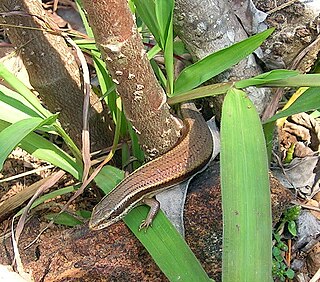
Eremiascincus is a genus of skinks, lizards in the family Scincidae. The genus is endemic to Australia, Indonesia, and East Timor.

Eulamprus is a genus of lizards, commonly known as water skinks, in the subfamily Sphenomorphinae of the family Scincidae. The genus is native to Australia.

The genus Sphenomorphus – vernacularly also known as the common skinks – currently serves as a "wastebin taxon" for numerous skinks. While most or all species presently placed here are probably rather close relatives, the genus as presently delimited is likely to be not monophyletic and is in need of review. Some species in this genus have been moved to Pinoyscincus.
Indotyphlops jerdoni, or Jerdon's worm snake, is a species of harmless blind snake in the family Typhlopidae. The species is endemic to India. There are no subspecies which are recognized as being valid.

The graceful leaf-toed gecko is a species of small-sized gecko found in India. The holotype was described in British India in Berar.

Kaestlea travancorica, also known as the Travancore ground skink or Barbour's ground skink, is a species of skink endemic to southern Western Ghats.

Sphenomorphus dussumieri, commonly known as Dussumier's forest skink and Dussumier's litter skink, is a species of skink, a lizard in the family Scincidae. The species is endemic to southern India.

Sphenomorphus indicus is a species of skink.

Lygosominae is the largest subfamily of skinks in the family Scincidae. The subfamily can be divided into a number of genus groups. If the rarely used taxonomic rank of infrafamily is employed, the genus groups would be designated as such, but such a move would require a formal description according to the ICZN standards.

Acontias gracilicauda, the slendertail lance skink or thin-tailed legless skink, is a species of skink. It is found in the Republic of South Africa and Lesotho. Acontias namaquensis was formerly included in this species as a subspecies, but is now recognized as a distinct species.

Geoscincus is a monotypic genus of skinks: the only accepted species is Geoscincus haraldmeieri.
Lankascincus dorsicatenatus, also known as the catenated lankaskink, is a species of skink, a lizard in the family Scincidae. The species is endemic to island of Sri Lanka.

Concinnia is a genus of skinks in the subfamily Lygosominae.
Sphenomorphus maindroni is a species of lizard in the family Scincidae. The species was originally described by Sauvage in 1879. According to the Catalogue of Life, the species Sphenomorphus maindroni does not have known subspecies.

Sphenomorphus annectens is a species of lizard in the genus Sphenomorphus of the family Scincidae, described by George Albert Boulenger in 1897. According to Catalogue of Life Sphenomorphus annectens does not have known subspecies.

Sphenomorphinae is a large subfamily of skinks, lizards within the family Scincidae. The genera in this subfamily were previously found to belong to the Sphenomorphus group in the large subfamily Lygosominae.

Pinoyscincus llanosi, also known commonly as the Leyte sphenomorphus, is a species of skink, a lizard in the family Scincidae. The species is endemic to the Philippines.
Sphenomorphus capitolythos is a species of skink, a lizard in the subfamily Sphenomorphinae of the family Scincidae. The species is endemic to Indonesia.
Sphenomorphus helenae, also known commonly as the Notaburi forest skink, is a species of lizard in the subfamily Sphenomorphinae of the family Scincidae. The species is endemic to Thailand.
Tytthoscincus butleri, also known commonly as Butler's forest skink, is a species of lizard in the family Scincidae. The species is native to Malaysia and Thailand.













